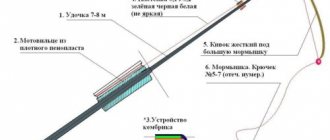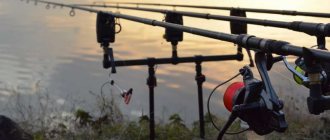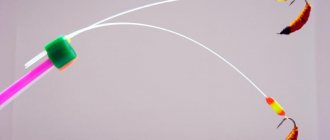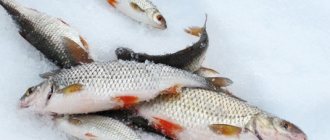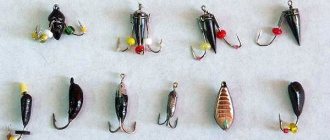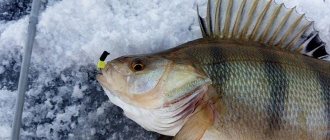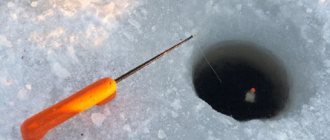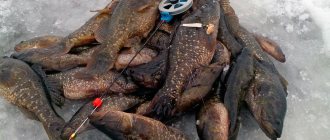A jig, which is a sinker, a bait with a hook, was originally invented for fishing in winter, but today fishermen are increasingly using such fishing tackle in the summer.
Fishing with jig tackle in the summer months is no less interesting than in the winter, but a jig for summer is usually made larger and heavier than a winter jig. And one of the reasons here is that when fishing on an ice-covered reservoir, the fishing line with bait is in close proximity to the fisherman, in the hole, almost under his feet. And in the summer, the fisherman has to cast the tackle at a distance of up to six meters, and in this case, the information communication along the “jig-nod-rod” chain is less sensitive. Therefore, in order to achieve mutual compliance of all components, it is necessary to choose larger jigs.
Rod
In winter, fishermen, using almost weightless fishing rods with light tackle, can play with bait with great frequency and only with movements of the hand. But when fishing in the summer, playing with a jig located at a considerable distance from the angler is both difficult and difficult.
Although the telescopic rod is made of carbon fiber to lighten the weight, holding and oscillating with such a “six-meter stick”, made even using modern technology and modern materials, is not an easy task, especially if you do it for several hours in a row. A six- to seven-meter rod is the optimal choice: with a longer length, it becomes very difficult to control the tackle, and if the rod is short, then you can only fish directly near the shore, where it is impossible to catch serious fish.
When fishing with a jig, skillful play with tackle is the main component of success. But casting distance is also important. There are no special rods for jig tackle, so each angler must choose for himself a rod of the required length, most suitable for his fishing conditions.
You can even use a spinning rod to catch bait such as a jig.
One of the options for a side nod at the end of the rod
Equipment
The gear used when fishing with a jig, depending on the method of attaching the fishing line, is divided into two types: “dead” and “running”. At the same time, they say, for example, that this fishing rod has a “blind rig”, and some other one has a “running rig”. By “blind rig” we mean a certain method of attaching the fishing line to the rod, in which it is attached to it “tightly” and reeled in with a small reel, usually installed on the third knee.
It is impossible to release the fishing line to a greater length with blind rigging. And since the shock-absorbing properties of the fishing rod are limited, if the fish being fished is heavy, the fishing line may experience heavy loads and, accordingly, break off at the most inopportune moment. And if this happens when fishing for a very large fish, then it becomes simply a shame: after all, every fisherman dreams of large catch. Therefore, when fishing with a blind rig, you must always have a landing net next to you. And it’s better if this landing net has a telescopic handle.
The main difference between a fishing rod that has a “running” rig is the nature of the operation of this rig, which is “running”, that is, not tightly attached to the rod, but capable of being lengthened or shortened depending on the situation.
The rods of such fishing rods have guides and a reel. The presence of a reel allows the fisherman to timely increase or decrease the descent of the fishing line when fishing, which theoretically makes it possible to catch fish of any size. The fish, having made a jerk, does not break the tackle, but, overcoming the resistance of the reel brake, simply unwinds a small section of fishing line from it. “The line has run,” the fishermen say in this case. That is why such equipment is called “running”.
On a fishing rod with running equipment, either an ordinary reel that does not have a dead brake, or a fly fishing reel can be installed. And the fishing line chosen, as a rule, is 0.1...0.25 millimeters thick, depending on the circumstances. In summer, using running equipment, you can fish at almost any depth of the reservoir.
How to make a spinning rod for microjig with your own hands
An important condition for successful fishing is the ability to play with a jig.
The choice and composition of gear largely depends on the method of fishing. For fishing from the shore, for example, you need a rod of about 4-6 meters, and for fishing from a boat, a two-meter rod is enough. Therefore, the choice of gear must be taken responsibly and take into account the nature of the fishing.
Choosing a rod. For jig fishing in summer, you need to select a light rod. Since “playing” from the shore with a six-meter fishing rod is not so easy, there is no need to take a longer rod. Currently, the lightest material for fishing rods is carbon fiber. Passage rings must be present, otherwise the line will always get tangled during the “game”.
The nature of the fastening of the gear. People distinguish between “deaf” and “running” gear.
- “Blind” or rigidly fixed tackle means that the tip of the fishing line is fixed to the end of the fishing rod, or a small reserve is wound on the reel, about the third knee. This method of fastening will not allow the line to be released at a sufficient distance when landing a good fish.
- “Running” or moving tackle is when the fishing line is threaded through guide rings and attached to a reel. The coil, in turn, can be inertial or non-inertial. This tackle will allow you to adjust the length of the released fishing line and effectively fight large fish.
- Nod. As mentioned above, a side nod is used for fishing. It is selected depending on the length of the rod and the weight of the jig. The longer the rod, the longer the nod. The ideal position of the nod is to have its tip slightly raised when the jig is empty. Experienced fishermen advise marking the tip of the nod with a bright color to make it easier to distinguish the bite.
- Mormyshka. As a rule, a jig for summer fishing is larger in size and weight than for winter fishing. Heavy jigs are used in strong currents or for catching large fish. Calm, not very intense movements can attract chub, ide, crucian carp, and sharp and fast movements can seduce perch.
The main attribute of successful fishing is the correctly set pace of the “game” of the bait. To enhance the attractiveness, you can attach a couple of bloodworms to the jig.
Making a jig at home is a fairly simple process. There are several quick ways to make your own bait. If you don’t have all the necessary tools and materials at home, you can easily buy them in a specialized store for fishing or repair work.
Fishing with a jig in the summer from the shore with a spinning rod is called “jimmy fishing” and is gradually gaining its fans. This direction allows you to catch with a spinning rod not only a predator, but also quite peaceful fish such as dace, crucian carp, carp, roach, and bream.
For this fishing method, ultralight trout rods, the lightest reels and ultra-thin fishing line are used. And this is not surprising, because you need to throw not a spoon or wobbler, but a jig whose weight does not exceed half a gram.
Attention! The rule in jig fishing is: the lighter the bait, the greater the catch!
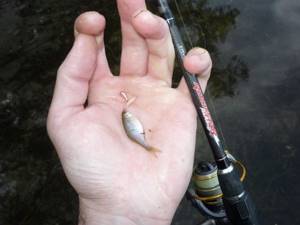
Next, let's dwell a little on the elements of the gear.
Rod
In mormo spinning, rods with a dough of no more than 4 grams of slow action are used. The length of the form is usually 210-240 centimeters.
Coil
The reel must be well balanced with the rod. After all, the cast is already not far, usually does not exceed 15 meters, and a heavy meat grinder can reduce the range to nothing.
In this case, the gear ratio should not be high, but approximately 4.6:1, as in traction models. This is due to the fact that fast postings are not done in mormyshing.
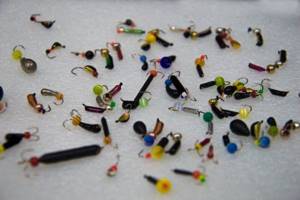
The line should be laid at a height. Not all models can evenly distribute the thinnest cord on the spool.
For beginner anglers, a monofilament with a diameter of 0.10-0.12 millimeters is better suited. It should be taken into account that you need to choose products from reputable manufacturers who guarantee high quality of the product.
On a note! As you gain experience, you can switch to cords with an indicator of 0.2PE according to the Japanese classification.
Lures
Various jigs are used, and the following are used as refills:
- microtwisters;
- pieces of edible silicone;
- artificial bloodworms and maggots.
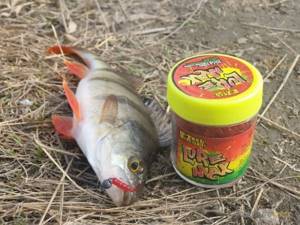
The perch was tempted by an ordinary jig with a shot and artificial bloodworms.
Fishing technique
Mormyshing uses the so-called nanojig or mormojig technique. In this case, after casting, perform the following actions:
- After casting, the slack is removed and the rod is lowered to a horizontal position.
- Shaking the form finely, gradually raise the rod to a vertical position.
- Lower the spinning rod back and select a fishing line.
- Repeat the steps in the same order.
The fishing technique is slightly different:
- Casting is carried out with the current, for this it is best to go into the water.
- After casting, the water flow will pull the line, and the bait will play in the stream.
- The reel is removed from the brake and the line is gradually released by twitching the tip of the rod.
- When biting, hold the reel with your hand from rotating and turn on the brake.
Retrieving is carried out vertically by moving the rod. Typically, for such fishing, lightweight carbon-fiber rods of fast or medium-fast action are used with a side nod installed on the tip, which helps to play with the bait and shows the bite. In addition, the side nod is to some extent a shock absorber during sharp jerks, especially if the rod is rigid. Without a shock absorber, there may be line breaks. (details about side nod)
You should start searching for fish from the top level, literally under the leaves of water lilies. Sometimes even large fish stay here and “lick” the larvae from the underside of the leaves. Probably most fishermen have heard sounds similar to the slurping of miniature piglets on a warm summer night or at dawn. Probably, these are carp, bream and other “white” fish that feed intensively in the grass, precisely at its surface level.
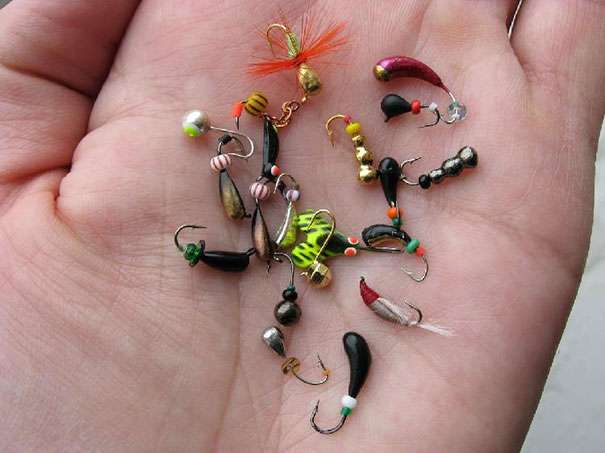
Fishermen believe that the jig is the most catchy bait in winter ice fishing, but in such conditions they use not spinning rods for fishing, but winter fishing rods with a nod, which are more convenient when fishing from holes.
The advantages of jig fishing when catching a predator are best manifested in October - November, when the water cools down, but is not yet covered with a crust of ice. The fish moves around the reservoir in search of food, “fatten” for the winter.
The jig, which looks like an insect, shows its best side in such conditions. The main thing is to choose the right shape and color of the bait and perch or pike perch will definitely be tempted by its appetizing appearance.
When catching peaceful fish, spinning fishing with a jig is more effective in the spring months, when the ice melts and roaches or rams stay near the shore in places rich in food. Before the start of spawning, the fish “responds” to light baits and replenishes fat reserves after long cold weather.
We suggest you familiarize yourself with How to decorate jeans with lace yourself
Light jigs or jig heads do not cause any concern in such conditions and anglers are guaranteed an active bite. When fishing from a boat with a short spinning rod, or a longer one from the shore, anglers find fish and achieve excellent catches.
In the summer months, jig fishing is not so effective, because most of the fish go to the depths, and catching them with a spinning rod with light bait is not so convenient. In such conditions, fishermen use other types of gear, putting aside jigs until better times.
Each angler has his own ideas about trophy fishing, and much depends on the gear used. It is not surprising that carp fishermen catch fish weighing 15–20 kg or more, because the gear they use allows them to achieve such results.
Using a spinning rod with a jig, it is unlikely that you will be able to catch a 20-kilogram fish, but light tackle gives an unforgettable experience when landing small fish.
Perch or roach weighing 200–300 grams caught with a jig tackle gives a serious fight to the fisherman, and it is not so easy to pull them ashore.
Naturally, heavier fish are found in the bycatch, but the main target is a predator or white fish weighing 100 grams or more.
The following can be caught using a jig with a spinning rod:
- bream;
- perches;
- ide;
- bleak;
- dace;
- ruff.
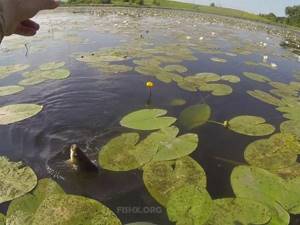
In general, for all the small fish that are in the reservoir, the main task is to find a promising place and choose the right bait. When fishing with a jig, spinners also come across zander and pike, and fishing for them turns into an exciting adventure.
Those who think that jig fishing is a simple type of fishing are seriously mistaken; only refined technique, the ability to “read” a body of water and correctly assembled gear help achieve solid catches.
The advantage of jig fishing over other types of fishing is the wide variety of fishing lines used in fishing. In addition to standard types of fishing, fishermen invent their own combinations that bring fish even when they cannot be caught in other ways.
The main task is to achieve such an animation of the bait (using the tip of a spinning rod) that will attract the attention of the desired trophy. You need to determine in what place and at what height the fish is standing, and by changing the types of fishing, this can be done easily.
Experienced fishermen believe that the choice of fishing line is an individual decision for each body of water, but it also depends on:
- type of reservoir;
- types of supposed trophies;
- depth at the fishing point;
- fish activity;
- season when fishing takes place.
After all, it’s one thing to catch a roach in a pond and quite another thing if you catch a perch or the same trout in a stormy river. The growing popularity of jig fishing is precisely due to the fact that it is used in those reservoirs where there seem to be few fish, but with the help of a spinning rod and a light bait it is possible to catch them.
Fishermen do not always have time to go to a rich body of water far from home, so jig fishing in the reservoirs of the park area becomes an outlet. It’s not even a matter of the size and number of trophies, but the opportunity to do what you love again and again and get great pleasure from it.
Wiring during nanojig is conventionally divided into three types:
- pulling bait in the bottom layer;
- wiring in the water column at an average level;
- animation of the bait near the surface.
The fish standing in the bottom layer are larger, but a light bait should sink faster, and the angler will feel how close to the bottom it moves. Crucian carp can also be caught with jig fishing, although not as large as with a float or feeder.
Nods
Nods on fishing rods with jig tackle can be lateral or straight. On long rods, side nods are more visible, which is why they are usually used.
In general, all fishing rods must have their own nods, which can be lavsan, steel or spring.
Side nods
The length of the side nods when summer fishing using jigs is chosen depending on the length of the rod. The longer it is, the longer the side nod it should be equipped with. A correctly chosen nod prevents sudden vibrations and allows you to make smooth and floating play with the jig. For example, if your rod is 6-7 meters long, then the side nod for it should be about 20 cm long.
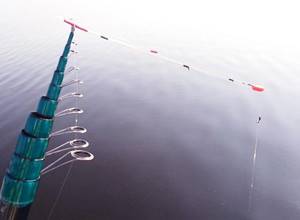
Telescopic fishing rod with side nod
When checking the correct choice of nod, you need to keep in mind that due to the action of the weight of the jig, the nod is usually in a horizontal position or goes down slightly, while without bait the nod bends slightly upward.
And since the jigs used for fishing can have different weights, then the nods should be chosen to pair with them, also different in length. The option of adjusting the size of the nod during fishing is inconvenient, since this requires more time than the operation of replacing it with another nod. Therefore, when going fishing, it is best to collect many different nods with different lengths.
It is useful to put multi-colored signaling devices on the tips of the nods, made of some light, brightly colored materials, for example, foam or pieces of colored tubes.
Varieties of jigs
Mormyshki are divided according to several criteria:
- According to the material from which they are made.
- To size.
- By weight.
- According to the form.
- According to the number of hooks and method of fastening.
- By color.
- According to the method of attachment to the fishing line.
Considering that each jig works well only with the corresponding nod, it is better to test all the baits at home so that when fishing you do not waste time selecting a nod.
It is impossible to say with certainty which jig is best suited for catching perch in the summer. Depending on a large number of conditions, any one can work. When catching perch in the summer, they use a thicker fishing line, about 0.15 mm, and therefore preference is given to larger jigs. You can use jigs of bright colors or additionally attach a bright tail or bead. Instead of a bead, a piece of edible silicone is sometimes used. It is better to use larger hooks, the main thing is that they are strong and sharp.
Having chosen the desired jig, you must remember that it must be tied correctly. The angle between the axis of the jig and the fishing line, equal to 30-40 degrees, helps create the necessary vibrations of the bait.
If the perch bites on a small jig, and the fishing conditions make it difficult to use (great depth, current), you can use two jigs. The first is heavy at the bottom, and the second is 10 cm higher on a short leash.
Jigs
Summer jigs are usually larger than winter jigs. Moreover, the heaviest of them are used when fishing in reservoirs with large currents or depth. And also when they are going to catch obviously very large fish.
The main thing when fishing with a jig is skillful play with such tackle, which largely depends on the experience of the fisherman. The vibrations of the moving jig catch the fish. With the right technique for playing with the tackle, you can count on biting exactly the fish you are hoping to catch.
Fishing with a jig in the summer is more difficult than in the winter, since it is more difficult to ensure good play with it. With the help of a slow, almost motionless game, you can attract bream, ide, roach, and attract perch with the frequency vibrations of the jig.

You can also use the following equipment: tie a hook on a leash, put a white cambric on it, and tie not one leash, but two or three, and each with a hook at the end.
In summer you can fish with a jig both from the shore and from a boat. But in the latter option, the use of jig tackle becomes very effective.
Jigs for perch in summer and fishing techniques
The optimal jig for open water fishing is considered to be the ant, which we wrote about in the article “Guaranteed success: jigs for perch.” This probably happens because these insects often end up in bodies of water and become prey for many species of fish. Droplet, wing, leech and oatmeal are also successful.
If a fisherman purposefully hunts humpback whales, then it is possible to seduce them with baits of colors that are close in color to the objects of animal origin that live in this body of water. They constitute the main diet of large perches.
If the jig does not contrast with the environment, it can not only not scare away worthy specimens of fish, but also provoke a predator to attack. The fact is that during their short, but full of dangers, life, humpback whales have more than once encountered such danger as bait, therefore they are able to be wary of everything unknown.
As for the wiring technique that the fisherman performs, there are not so many of them. The goal of any game is to make the fish react to the bait offered, even if the predator is sluggish and not very keen to attack the bait. Let's look at a few of them.
Stepped wiring, which jiggists love so much:
- The jig is lowered slowly, performing a smooth amplitude from side to side.
- When reaching the ground, they pause, waiting for a bite; if this does not happen, they begin to tease the predator again.
- The bait is raised by 40-50 centimeters and made in circular movements, after which it is again placed on the bottom.
A similar pattern is repeated again and again in anticipation of a bite. As a rule, the perch is tempted after a couple of circles, when the bait moves up. The nod instantly bends or straightens, signaling a hooked predator.
The game can be diversified with high-frequency wiring:
- The jig smoothly descends to the bottom with slight fluctuations.
- When the bottom is reached, a short stop is made, then in the same spirit the bait is raised up thirty centimeters.
- After a pause, the bait is lowered again, but the pause is already made approximately five centimeters from the ground of the reservoir.
Further rises must be increased over and over again in order to lure the predator as close as possible. With such fishing, bites most often occur during pauses, so you should not relax.
During a weak bite, the following wiring sometimes helps out:
- When the jig touches the ground of the reservoir, you need to stop for 5-6 seconds, then sort of fiddle with it at the bottom.
- There is a pause again, then you need to tap the bait on the bottom of the reservoir.
- The bait is pulled up with slight vibrations and after a long stop the process is resumed.
Fishing in the current is a little different. For example, below the dam there are areas with relatively calm water movement. As a rule, they can be found near a steep bank, where there is a protrusion into the water or another obstacle. In this place, along with roach, minke whales accumulate there, waiting for food to rush past.
Bloodworms or a small worm are used as bait. The equipment is thrown into the water so that it drifts with the current not far from the cliff, while it should move as naturally as possible. The fisherman’s skill lies in competently controlling the tension of the line in order to notice the bite in time and react to it.
www.udim.ru
Features of fishing from a boat
When fishing from a boat, you can use the same short fishing rod that was used in winter, while the line must be wound on a reel and pulled through the nod, and a jig must be tied to its end. Instead of a reel, a coil can be used. You need to choose strong hooks, and choose jigs that resemble live food in appearance. You need to fish either near the bottom or a little higher.
In the spring it bites well in shallow water, but with the arrival of autumn the fish begins to look for deeper places, so at this time it can only be found at depth: in holes and pools.
How to fish in still water?
When fishing in lakes and ponds, you need to cast the jig as far as possible, and after it reaches the bottom, pull it jerkily or drag it along the shore.
The jig needs to be raised slowly, making stops, after which it needs to be lowered a little. While playing, you can tap your finger on the rod in the place where the reel is attached to create vibrations of the tackle at a certain frequency.
If the bottom of the reservoir is covered with vegetation, then the jig needs to be thrown into those places where there are no plants, and which are therefore called “windows”. The jig must be cast to the farthest point of the window, otherwise snags cannot be avoided during the game. If the bait is live bait, then you can also catch pike with it, but most often perch is caught in the windows. During the fishing process, you need to move all the time: you shouldn’t stand in one place for a long time, if there is no bite, after making several unsuccessful casts, you need to go fishing in another window.
Perch fishing technique
Perch walks through the expanses of the water area all year round, looking for food for itself.
As you know, this is a schooling fish and if an angler attacks a school, then luck will not pass him by. In winter, it is much easier to find perch, since the reservoir is covered with a thick layer of ice. In this case, the fisherman, coming to the reservoir, drills several holes, about 3-6 at a distance of 1.5-2 meters from each other.
So-called test casts are made into these holes. If there is no bite in one hole, then you should move to another. Having gone through all the holes and not finding any bites, you need to try another part of the reservoir using the same method.
If a perch bite follows, you need to feed this hole with a bunch of bloodworms so that the perch remains in place as long as possible.
When the bite weakens on a given hole, move to the next hole and so on.
Using this method, the angler will know the movement of the school of perch and will follow their route under water. When catching perch with a jig in the summer, a long plug rod with a nod bite alarm is used. But due to the length of the rod, the game takes on a different character in the behavior of the jig in the water.
Having figured out the perch spots on the reservoir, you should experiment with the choice of jigs. To do this, you need to lower the selected jig into the water to the very bottom, then, tapping on the bottom, lift it from the bottom using the game.
Using a nozzle-free fish
The technique of fishing with a baitless jig is not accessible to everyone, but only to experienced fishermen. When fishing with a baitless jig, you need to have well-chosen gear and be able to create the required, usually high, vibration frequency. It is also important to be able to choose the “right” jig: for example, fish bite well on lead jigs with a light-colored hook. At the same time, you can experiment using PVC tubes of different colors.
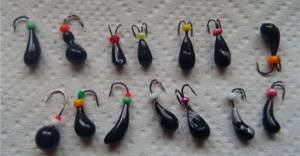
Reelless jigs
What types of lures are there for catching perch in summer?
In order for your catch when fishing for perches to be largely successful, you should properly prepare for the fishing process and select the necessary lures. Nowadays, there is a great variety of all kinds of lures for fishing for individuals of the perch family.
Often, fishermen try to use a type of rotating spoons (spinners) to catch striped predators. When using this type of lure, water vibrations are created that are quite attractive for this fish. This type of spoon is the most common among all anglers.
Spinner spoons continue to be quite effective. The main thing is to choose them in such a way that they are oblong in shape and weigh no more than fifteen grams. The best color options would be greenish and yellowish vibrators that have a slight metallic tint.
To achieve a more successful catch when fishing for striped bass, you should stock up on a wide variety of spoons, which can ensure your fishing in a variety of conditions.

